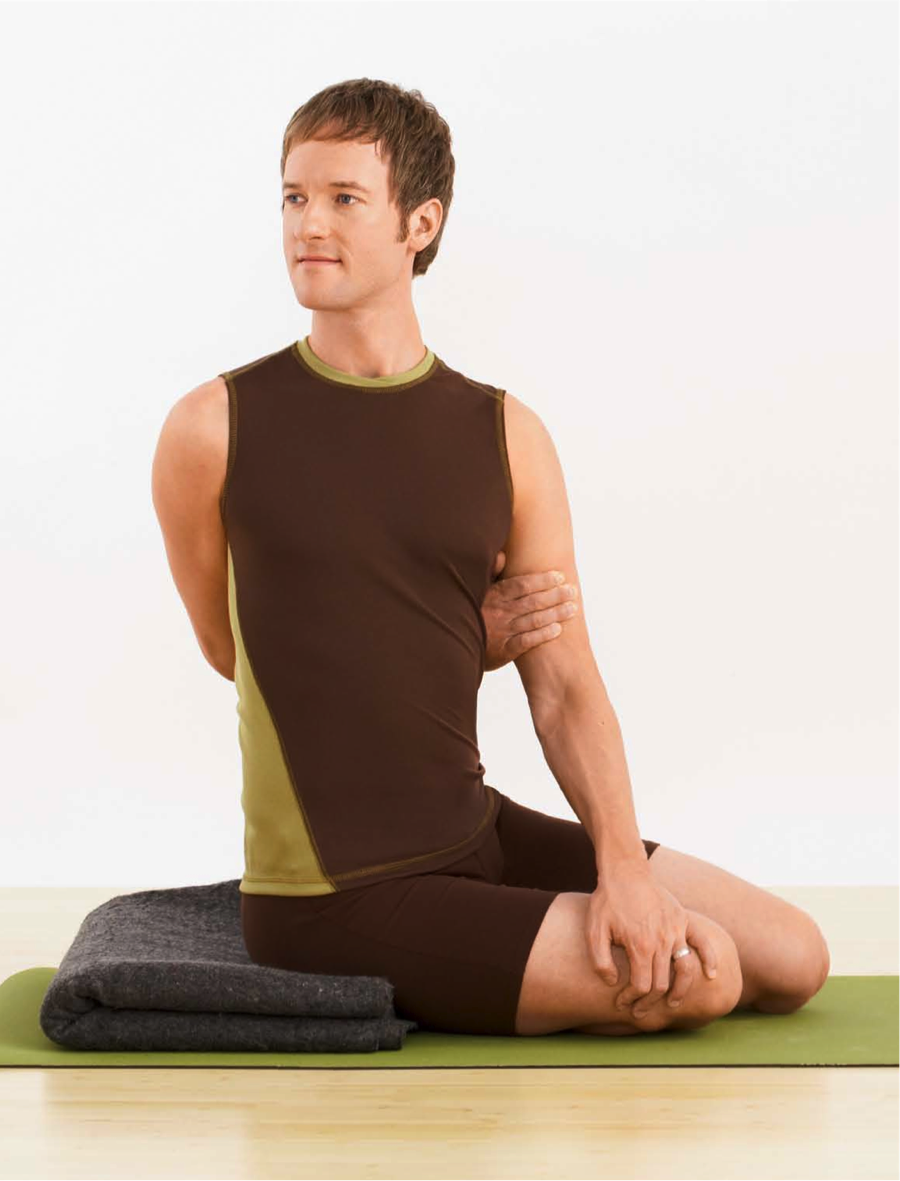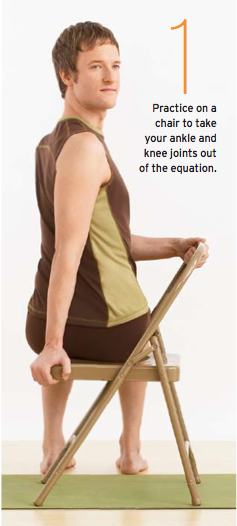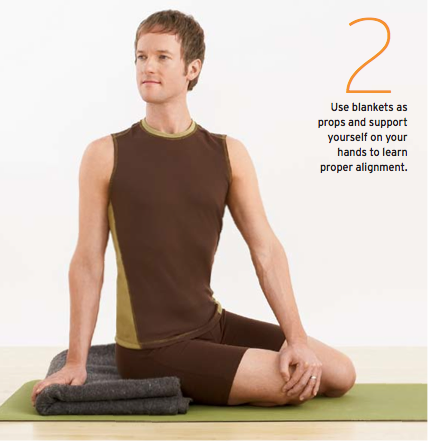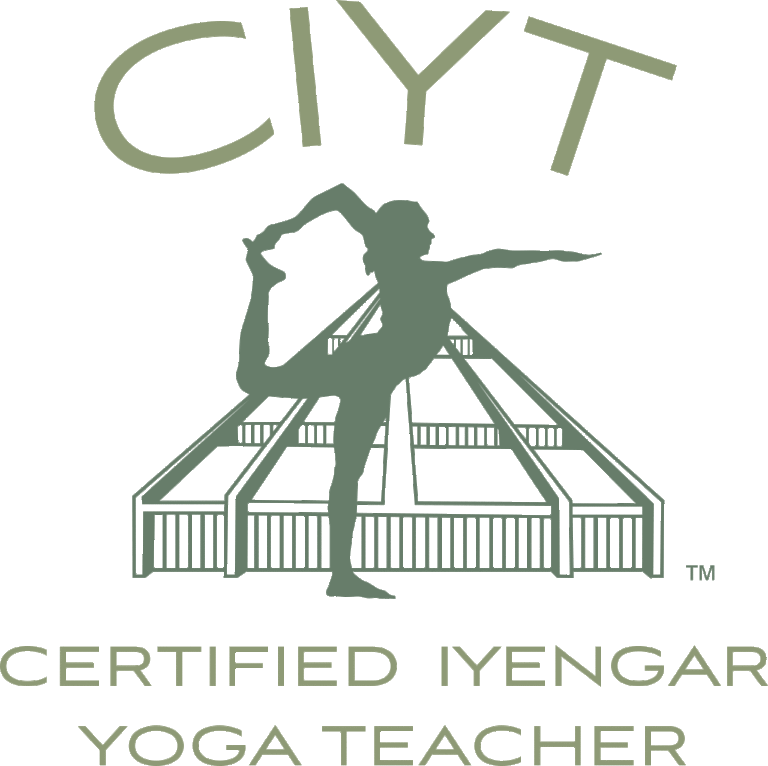
At first, twisting asanas can look disorienting but when done well, they can actually be very balancing. When an object rotates, it turns around a center, stable line, or axis. Whereas many twisting asanas have an axis that like the Earth’s, is slightly tilted, Bharadvajasana’s axis is straight, perpendicular to the floor like the center pole of a carousel around which the chest rotates.
Unlike some other twisting poses where your legs and torso are tightly bound together, here the whole torso is free to turn. In fact, since the abdomen is not constricted, this is one of the only twists that can be safely performed during pregnancy. If you are stiff or a beginner, you will find this to be an accessible twist. The spinal muscles benefit from the stretching, lengthening and rotating involved in the pose and it can help loosen your back, shoulders and neck.
So your challenge in Bharadvajasana is to not get swept away in the twist but to remain mindful of holding your axis tall and upright. Balancing yourself along your central channel can be mentally as well as physically centering. Your spine is like your own axis mundi, cosmic connection between the earth and sky, the material and the spiritual. As you turn, you don’t want to disturb the evenness of the two sides of your body.
Yoga philosophy explains how the constantly changing nature of life causes physical, mental, and emotional hardship. It is easy to be thrown off balance by the daily flux of experiences. In your yoga practice you learn to tap a source of calm and stability that is accessible throughout life’s twists and turns. Stabilizing your upright mid-line while twisting in Bharadvajasana can be a training ground for finding inner balance and equanimity when faced with your greatest challenges.
In this pose you sit with your bent legs on one side of the body while your chest turns away from the legs. The leg and hip that you are twisting away from need to remain grounded so that the spine doesn’t tilt. In the first variation you will sit on a chair to focus on lifting and opening the chest while turning. If you are stiff in the ankles, knees or hips, this variation will enable you to twist without any strain on your joints. In the second variation you will use your legs and arms to balance your pelvis and to help keep your torso straight while sitting on the floor. In the final pose, you will clasp your hand behind your back to give further opening to the chest and shoulders and to deepen the twist. These variations make it progressively more challenging to keep your center perpendicular. The pose requires an inner strength and resolve since its external strictures are minimal.
Sit on the right side of a chair that has a flat seat and no armrest, such as a folding chair. Place your feet hip width apart and parallel to each other on the floor, your knees directly above your feet. Turn to face the back of the chair and place your hands and hold the top of the backrest. Inhale and lift your chest up, exhale and turn to the right.
Don’t lean forward or back but keep the torso completely upright as you broaden the chest and turn. To maintain your vertical axis, keep your hips even on the chair and twist only the upper body. If your left knee is jutting in front of the right, you know that your pelvis is shifting. Keep both buttock bones down and the knees aligned as you lift your torso. On the inhalation lift and separate the ribs from the pelvis. On the exhalation turn from the ribs without disturbing the legs and hips.
To further open the chest, exhale and reach your right arm back behind you and catch with your hand the corner of the seat of the chair by your left buttock. Bend your right elbow, pull on the seat of the chair and roll the outer corner of you right shoulder back as you turn your chest to the right. You will feel a stretch across the front of the right shoulder. Take your left shoulder back and open the left side of the chest as well. Move your shoulder blades and upper back ribs forward toward your chest to support the lifting of the chest and opening of the shoulders. Sit balanced on both buttocks, lift both sides of the ribcage and chest evenly upward so that your collar bones are level with the floor while turning. Don’t arch your lower back but pin your outer shoulders back, exhale and turn your chest and head to the right. Inhale and gently release from the twist and come back to the center. Now sit on the other side of the chair and twist to the left.
Sit on the front edge of two folded blankets with your legs stretched straight in front of you in Dandasana (staff pose). Shift your hips to the left side of your blankets so that only the right buttock (not the thigh) is on the front edge of the blanket. Bend your knees and fold your legs and feet to your left side. Keep your knees and thighs facing straight forward in line with your pelvis and rest the top of your left foot on the arch of the right foot. The toes on your right foot should be pointing to the left away from your body while the left toes point straight back behind you (like in Virasana, Hero pose). The right foot forms a seat for the left foot and the feet form the shape of the letter T. Don’t sit on your feet but have them beside your pelvis so that you can drop the left buttock into the space between the blankets and your feet. Both knees should be on the floor. If this is painful for your knees or ankles, you can add more blankets to your lift. If extra blankets don’t help or you find it difficult due to stiff or injured knees, ankles or hips, you can continue to use the chair as in the first variation.
Place your right hand beside your right hip on the blanket and facing forward, balance your pelvis so that you aren’t tilting to the right. If you find yourself leaning to the right side, push off with your right hand to help you drop the left buttock downward. Lift the sides of the ribcage evenly so that if you were photographed from the waist up in this position, it would not be possible to see in the photo that you are sitting asymmetrically. Now cross your left hand in front of you and hold the outside edge of the right knee. Place your right hand behind you on the blanket.
Inhale and lift the sides of your chest up and exhaling, turn your chest to the right. Roll both shoulders back and broaden your chest. Keep your left outer hip and buttock descending even though the left side of your chest is ascending so that the left side of your back is lengthened. To remain grounded on the left side as you turn to the right, roll the outer edge of your left shin and little toe to the floor.
In this variation the right hand is helping you to keep your axis vertical. Don’t lean back on the right arm but push off of your right hand to help you put weight on your left shin. As before you began twisting, keep both sides of the torso parallel with each other.
Roll both shoulders back as in the first variation on the chair and move the shoulder blades forward. When you keep the left buttock down and the axis of the spine centered, you will prevent your lower back from overarching. Move the upper spine, shoulder blades, and back ribs forward as you exhale and turn to the right.
The heart center should lead the way in the twist, not the head. Open the chest and turn from there. Keep your head aligned with the spine so that from the crown of your head to your tailbone, your axis is in a vertical line. When your head and spine remain centered, you can be mindful of the balance in the pelvis and although you may not feel as though you are twisting as far as possible, you will feel the calm centering quality of the pose.
Inhale and turn back to the center. Stretch your legs straight in Dandasana and shift to the right side of your blankets and swing your feet to the right to twist to the left.
Variation #3
Sit on the blankets as in the previous variation with your feet on your left side. Bend your right elbow, reach your forearm behind your back and with your right hand clasp your left upper arm, just above the left elbow. If you are unable to reach the left arm, put a belt around the left elbow and hold the belt with your right hand. Roll the right shoulder back to broaden the chest. Now reach in front of you with the left hand to hold the outside edge of the right knee. If you can’t reach the knee, hold the outer right thigh or inner edge of the left leg. After you’ve turned, you may be able to crawl your left hand closer to the right outer knee.
As in the previous variation, drop your left buttock and outer hip down towards the floor as you lift the left side of the chest. Exhale and revolve your chest from left to right. You will feel a stretch in the front of the right shoulder as you take your right shoulder back. If you are able to reach your right knee, try to stretch your left arm straight. It should feel like the left arm is pulling your right shoulder back more, turning you to the right. Cut the right shoulder blade in towards the spine and forward towards the chest. Move the left shoulder blade towards the chest and lift the left side of your chest towards the ceiling.
Notice if your spine is still perpendicular to the floor or if you are leaning to the right side. Exhale as you cut your outer left hip down towards the floor and inhale to raise the left side of your waist and ribs. Maintain an even lift along the right and left sides of your ribcage as you exhale and turn around your axis. As you find the balance between lifting your chest and spine, revolving, and remaining tall and upright along your central channel, you can experience stillness within the motion and your own source of inner calm.




